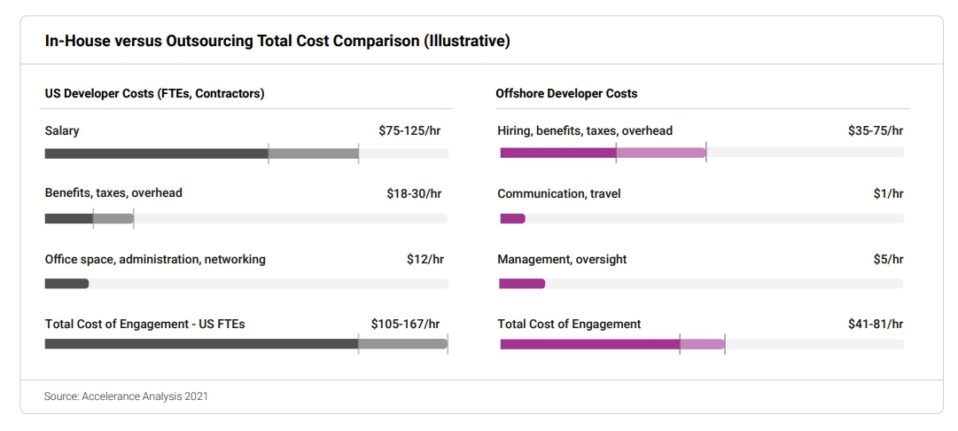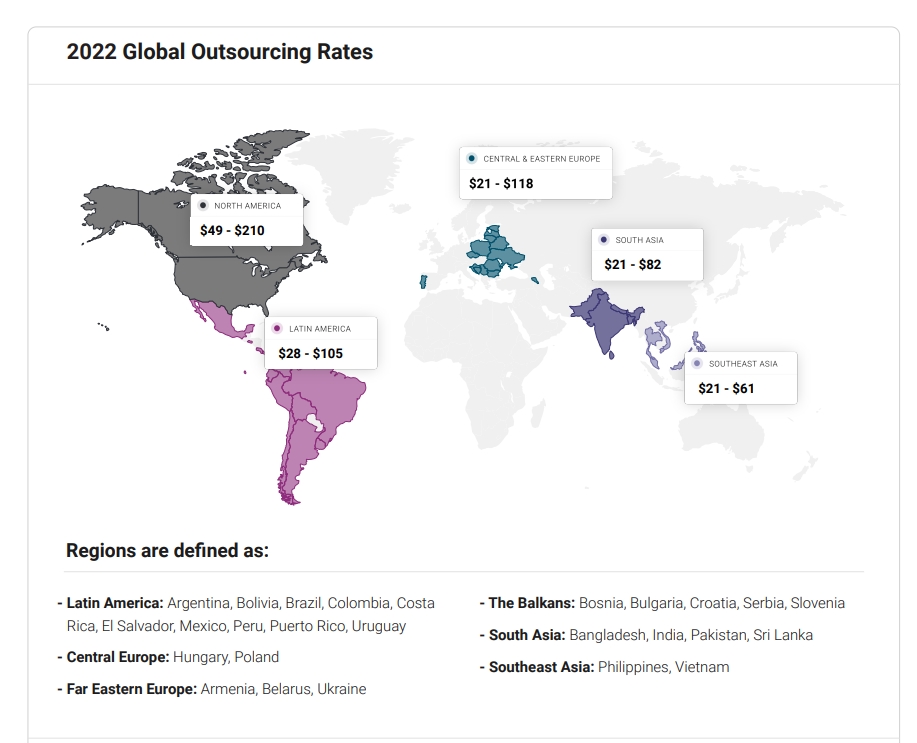There is always a scarcity of global tech talents, but today the gap is much more than ever. According to Manpower Group research, 69% of US employers are struggling to find skilled workers. It makes sense when many companies increasingly turn to tech solutions and digitize themselves to address their current business challenges. This makes business owners face a lack of software engineers and high competition in the market. However, the number of software engineers available isn't growing as much as the demand for them is. If so, businesses need to do more than solve the problem in the long run.
In this article, we will go through the top reasons causing tech talent shortages in the United States and provide you with 4 practical tactics you can apply to deal with the issue. You will discover an overview of the best countries to outsource software development to fill the US tech talent gap.
What factors cause the high demand and low supply of tech talent in the United States?
It's estimated that there will be a global shortage of more than 37 million qualified workers in 2022. If the US labour market cannot attract enough IT expertise, this may lose out on $162 billion in annual revenues (Korn Ferry, a Los Angeles-based management consulting firm). Gartner also reported that many IT executives identify talent shortages as the most significant barrier to adopting emerging technologies, ahead of cost and security.
Here are the top reasons causing the high demand and low supply of tech talent in the United States:
- The high competitiveness in recruitment among businesses and many tech powerhouses like Google, Microsoft, IBM, Meta (formerly Facebook), Apple, and many more. They are pioneers in the tech industry and always precede others in hunting for the best IT staff with high salaries and excellent benefits. This has also inflated the wage demands of local tech talent, thus forcing companies to spend more to retain or hire talent.
- The labour market grapples with the lack of domestic tech talent. In fact, the US only graduates 65,000 college students each year with tech-related degrees, and most don't graduate with the "last mile" training required to be employable. Therefore, the slugging market of IT talents cannot meet the requirements of IT firms, both in quantity and quality.
- There is increased competition as more companies continue their digital transformations. Spending on digital transformation is expected to reach $1.8 trillion in 2022 and grow to $2.8 trillion by 2025 (Statista). The rising need for developers has put further pressure on the labour market.
- Employers face problems filling vacancies when baby boomers aged 65 and older begin to retire. As of October 2021, there were 3.3 million, or 7%, more retirees than in January 2020. It's obvious that employers will need a strong workforce plan to replace existing workers.
- In recent years, the number of H-1B visas has been decreasing. For a long time, US corporations have relied on immigrant IT expertise. However, the pandemic and government policies have made relocating to the United States difficult for immigrants. This constraint has created a great lack of tech talent shortage and hard-to-fill tech jobs in the country.
- Reluctance is another factor leading to a lack of skilled employees. Most staff members are not ready to upgrade their competencies in order to manage future occupations associated with automation technologies, such as AI, machine learning, and other advanced tools. Thus, the workforce needs more skilled employees like engineers and scientists than earlier.
4 practical tactics to overcome the US tech talent shortages
If businesses can’t access the required talent to develop their software solutions, innovation can become stagnant, hurting the diversity and drive of the entire business landscape.
The question is: Is it possible to handle the development talent shortage? There will be no one-size-fits-all response to this question, as many approaches to coping with a talent shortage. They may differ based on each specific scenario. In this blog scope, we will provide you with 4 essential tactics to overcome this shortage.
Training and upskilling for internal talents
The first solution is training and upskilling internal employees. Technology continues to transform the way most organizations operate rapidly. In response, companies and their employees are forced to expand their technical knowledge and skill sets.
Upskilling is a workplace trend that facilitates ongoing learning by expanding a current employee's abilities and minimizing skill gaps through training programs and development plans. Overall, upskilling is critical and essential when:
- Job positions and their requirements are changing faster than ever;
- Employees expect more growth opportunities within their companies;
- It enables an organization to stay more competitive by filling skill gaps and fitting the growing business expectations;
- It reduces the need for hiring, onboarding, and training processes outside the company;
- It enhances employee satisfaction, motivation, performance, experience, and morale;
- It also increases employee retention.
For example, as part of its Upskilling 2025 pledge, Amazon has set an upskilling roadmap for more than 300,000 employees with a budget of $1.2 billion for free training programs by 2025.
On top of that, this approach also helps the company become more attractive to job applicants.
Update employees’ benefits to attract and retain employees
Tailoring their benefits offerings is also a practical approach for businesses. This requires finding the intersection between what you need, the type of talent you can find, the new technology trends, and the budget available for the position. Today, offering a high salary isn't enough anymore. Jobseekers want to work for inclusive organizations that offer competitive and great benefits and align with their goals and values. Business owners should keep this in mind when considering which strategies they can use to not only attract the best workers but also keep them long-term.
You can start this process by surveying existing and potential employees based on what types of benefits would interest them the most. Given that, you can utilize that data to make benefits decisions. The benefits packages can cover health insurance, ample professional development, flexible work, leave benefits, performance bonuses, employee engagement programs, family care, retirement planning, and so on. Ultimately, the company's benefits package should align with the company's culture.
For instance, in an attempt to retain employees, Pinterest has introduced updated parental leave policies and fertility plans. Meanwhile, Finder has announced extra 5-day leaves.
Reducing the time to hire
The third tactic is to reduce the hiring time without rushing into a hiring decision. The time to hire is the number of days from when a candidate applies to accept an employment offer. Applicants today expect businesses to have a timely, efficient, high-touch hiring process. You can't hope to win in this competitive context with traditional hiring practices involving multiple rounds of interviews, leading too time-consuming.
The good news is that it's possible to speed up the recruitment process, from eliminating time-wasting activities and improving candidate evaluation to streamlining processes with automation. You can access valuable insights and huge distributed talent pools through talent recruitment platforms.
Keeping the hiring process quick and sweet offers your business several advantages:
- It saves your HR department time and hassle.
- It enables you to screen candidates thoroughly, better hiring accuracy with highly qualified candidates, and lower turnover rates.
- It helps to save money and improve budget forecasting as you don't waste valuable resources.
- It reduces the risk of losing out on the best people when they tend to put off long interview processes if they apply to multiple jobs.
- It allows for maintaining productivity as you don't have long gaps between employees and hand over smoothly.
Outsourcing
Outsourcing is the new normal. Leveraging offshore outsourcing, nearshore, and remote talent pools is one of the most promising strategies to balance the talent shortage in the US, especially when a company demands highly-skilled workers.
The widespread adoption of the new business model of remote labour has forced businesses to dump traditional employment practices and turn to outsourced development teams. Outsourcing has become increasingly popular because offices shut down and businesses are affected. As additional data protection solutions and remote working tools have emerged, working with a remote team is becoming incredibly simple.
Even if cost is no longer the leading factor for most businesses to consider outsourcing software development, cost savings are certainly an expected outcome. The average rate for an engineer with equivalent skills and expertise in Asia, Latin America, or Eastern Europe is far lower than in the United States, the UK, or Australia. Due to domestic talent shortages in the US, outsourcing enables companies to fill gaps in their teams, access the right tech stacks, and utilize fractional skill sets without sacrificing quality. Therefore, organizations can focus on their core business operations, save time and money, and cut down overheads such as office rent, office equipment, insurance, and staff benefits.

Source: 2022 Global Software Outsourcing Trends and Rates Guide by Accelerance
Remote: As more and more companies turn towards a mobile workforce, engineers can be anywhere as long as they have an internet connection. A Gartner survey reveals that roughly 74% of companies want to adapt permanently to remote work. Apart from reducing operational costs significantly, remote work is here to stay for several other reasons, including work-life balance, reduced travel time, less micromanagement, and high productivity.
Nearshore: With nearshore software development, you can outsource your development work and IT services to teams and employees in neighbouring countries. This service offers significant benefits like reduced time zone differences, low cost of labour, minor but insignificant cultural differences and language barriers, and others. Despite the advantages, there are still specific difficulties in even the best locations for nearshore software development. So ensure you choose the suitable one.
Here are some ideal destinations when hiring nearshore development teams for custom software development projects.
- Latin America – Brazil, Argentina, Mexico, Chile, Colombia, Costa Rica;
- Eastern Europe – Poland, Ukraine, Romania, Russia, Belarus, Hungary;
Offshore outsourcing refers to a country far away from yours, maybe on the other side of the planet. Businesses prioritizing quality above location opt for offshore locations where superior quality is delivered at competitive prices. Some powerful advantages offered by an offshore software development team are
- A worldwide talent pool;
- Highly-qualified experts available at affordable costs;
- Dedicated IT team to handle a comprehensive range of services;
- High service quality within given schedules.
Asia seems to be a 'paradise' for organizations looking to hire a dedicated team for offshore software development outsourcing. There are popular countries, including
- Southeast Asia – Vietnam, The Philippines, Malaysia, Indonesia;
- South Asia – India, Pakistan, China, and Bangladesh;

Source: Accelerance’s 2022 Global Software Outsourcing Trends and Rates Guide
Undoubtedly, companies that embrace remote work and outsourcing will have an advantage in the coming years. The beauty of IT outsourcing is that you can choose from nearshore and offshore outsourcing countries to receive high-quality work and save money. Understanding how to use outsourcing can help you achieve your business goals, create amazing teams and produce remarkable experiences for your customers.
Best countries for outsourcing software development
With the relentless tech talent shortage, US companies are flocking to global hot regions for their deep developer talent pools at cost-effective rates, along with its desirable proximity. Qualified software engineering teams are not easily found. Software development outsourcing also is a complex process, and naturally, there are countless questions.
- How do you choose the right location?
- How do you know where to look for a high standard of skills and expertise at the most competitive rates?
- Which international talent pools are overused, and which are overpriced?
- What business and political conditions create the best opportunities?
The data may differ, but in most lists of the best countries to outsource software development, you can most often find Brazil, Ukraine, Poland, India, Vietnam, the Philippines, and some other destinations. In this article’s scope, we will compare these top countries in nearshore and offshore software development. It's a go-to source for informed decision-making, whether you're considering outsourcing for the first time, re-evaluating an outsourcing partnership, or conducting benchmarking.
Brazil
As the largest economy in Latin America, Brazil is a popular destination for hiring nearshore development teams. The IT sector in Brazil has shown remarkable growth in recent years, and investment is very high. In 2021, Brazil's information technology market was worth 45.7 billion US dollars, while the software market accounted for 11.3 billion US dollars (Statista). It also has roughly 90 tech parks like the Campinas and São Paulo. Brazil allocates good funding and resources to develop its core IT infrastructure. According to the Global Services Location Index (GSLI), this country ranked among the top 5 places for IT outsourcing regarding financial attractiveness, investment climate favorability, technical candidates' capabilities and availability, business environment, and digital resonance.
The most significant advantage of nearshore outsourcing is the possibility of real-time collaboration with your team, thanks to a full workday overlap with US time zones. This facilitates communication and eases international visits if needed. Yet Brazil's work culture is a little peculiar, so you'll need to learn the specifics to avoid a cultural clash between your team and the outsourced team.
- Timezone: GMT-2, GMT-3, GMT-4, GMT-5
- Number of developers: 500,000+
- Top tech cities: Campinas, São Paulo, Rio de Janeiro, Florianópolis.
Poland
Poland is often considered as a tech hub of Europe. You can choose to nearshore software development in Poland to overcome the problem of staff shortage. The IT market in Poland is constantly expanding. Poland's IT outsourcing services industry generated a record-breaking $2,255.05 million in revenue in 2020, according to Statista. That is an increase of 112.5% from 2016 and five years of continuous growth. The same report also mentioned that the IT market was projected to reach approximately 12.4 billion U.S. Dollars in 2021, indicating COVID-19 hasn't hit too hard to the Poland IT industry.
Poland was placed 14th among the top 20 digital nations according to the Tholons Globalization Index 2021. Additionally, the same index reports that Krakow belongs to the top 20 super cities in digital innovation. Poland has a growing IT talent pool, and the IT industry is growing at a steady rate of 5-10% yearly. There are now 250,000 programmers working in Poland, accounting for as much as 25% of the overall developer community in the Central and Eastern European region by Stack Overflow. One of the most considerable advantages of outsourcing a development process to Poland is that there's nearly no cultural gap, and it has a good communication ability in English.
- Timezone: GMT+2
- Number of developers: 250,000+
- Top tech cities: Warsaw, Krakow, Wroclaw, Katowice.
Ukraine
Ukraine is one of the Central & Eastern European countries becoming increasingly popular among those looking for IT outsourcing services. The country is home to more than 200,000 IT specialists, and the number is expected to double by 2025. Therefore, Ukraine is now the fourth-largest supplier of tech talent globally, with a corresponding growth in the number of outsourcing companies.
Ukrainian IT companies are actively growing in numbers, hiring more staff, and opening offices in new locations. The startup community is also active in Kyiv, Dnipro, Lviv, Kharkiv, and Odesa. The absence of solid legal restrictions or trade unions makes Ukraine one of the Top 3 destinations for the outsourced software development team. The government announced an $18 million fund to invest in startups in 2020. Ukraine exported IT services worth more than $5 billion that year. The country's IT sector grows by 20–25% yearly.
Like Polish developers, Ukrainian business etiquette follows norms close to those in Western Europe and the United States. Therefore, Ukraine is an ideal location to set up a nearshore development team.
- Timezone: GMT+2
- Number of developers: 250,000+
- Top tech cities: Kyiv, Kharkiv, Dnipro, Lviv, Odesa.
India
India has been known as a hotspot outsourcing destination with a large number of software developers and programmers. Many businesses worldwide have joined hands with Indian companies to outsource their software development.
The ICT sector in India employs more than 4.4 million people and will be worth $194 billion by 2025, or close to 8% of the GDP. Gartner forecasts indicate that IT spending in India is predicted to rise to US$ 101.8 billion in 2022 from US$ 81.89 billion in 2021. India also continues to produce the most significant number of graduates annually. In addition to having a thriving IT community, the country has good conditions and enough resources that favor adequate outsourcing development facilities. India’s government highly supports the software outsourcing industry with several initiatives. In 2017, the government spent over 100 billion dollars on building infrastructure and strengthening the IT sector. The government has adopted the “National IT Task Force” 108-point Action Plan to boost this sector. The nation’s cyber law is also on point to guarantee no threat to your security or intellectual property.
A low-cost workforce plus a pervasive English proficiency make it an attractive outsourcing choice. However, many people have apprehensions that such low costs would mean a tradeoff for low-quality codes. You need to consider and evaluate fully before choosing an outsourcing destination.
- Timezone: GMT+5:30
- Number of developers: 200,000+
- Top tech cities: Delhi, Bangalore, Mumbai, Pune, Hyderabad, Gurugram
Vietnam
Another popular outsourcing destination in Asia is Vietnam. This country is now emerging as one of the world's leading offshore software development outsourcing countries. Vietnam provides a large pool of highly educated and talented software development professionals at reasonably affordable prices. Many companies in the United States, North America, Europe, Australia, and Singapore now consider Vietnam a strategic option for cutting costs and balancing quality.
According to the Ministry of Information and Communications (MIC), the ICT industry earned revenue of $136,153 million in 2021, higher than $124,678 million in 2020. The country has emerged as one of the most attractive offshore outsourcing destinations in the world thanks to quality and cost-effectiveness geared to meet Western business expectations. Many software giants, including Microsoft, IBM, and others, have partnered with Vietnamese service providers to accomplish their projects.
Vietnam is also considered the black horse within the software outsourcing industry, as it is one of the most famous, consistent, and fastest-growing BPO markets. With the country's political stability, economic growth, and quick and effective actions to the Covid-19 situation taken by the government, Vietnam enjoys a safe and peaceful working environment with minimum conflicts in religion and social politics. More importantly, the Vietnam government continuously supports technological growth and endorses foreign investment opportunities. A "follow the sun" concept can take advantage of the time zone difference by adding hours to the workday through continuous, round-the-clock deployment. Development teams can also be ready to create flexible schedules that provide you with the necessary work schedule overlap. All these factors add up to Vietnam as an emerging and trusted hotspot for offshore software development outsourcing.
Read also:
- Key numbers to look at when outsourcing software development in Vietnam
- Why Vietnam to Outsource Software Development
- 14 Insights into Vietnam Outsourcing Software Development
- Timezone: GMT+7
- Number of developers: 430,000+
- Top tech cities: Ho Chi Minh, Ha Noi, Da Nang.
The Philippines
This list wouldn't be complete without the Philippines. In addition to having a strong economy, the IT sector is one of the fastest-growing and most dynamic industries in the Philippines. Like India and Vietnam, the Philippines' software development outsourcing sector is backed by firm governmental support. This means that the Philippines government greatly values the outsourcing landscape and provides several friendly initiatives to make collaboration with IT talent much more accessible.
The Philippines also owns a large pool of IT talent and outsourcing companies. According to PISA (Philippine Software Industry Association), more than 190,000 technical experts are working in the country, which is expected to reach 210,000 by 2022. Also, the country's software industry was projected to rise to 7 billion dollars by 2020. According to Jonathan De Luzuriaga, the PSIA President, the country will also increase its market share in the universal IT sector from 12% to 15%. The Philippines ranks 9th on the Kearney assessment for financial attractiveness and diverse digital skill sets. Another advantage of outsourcing with developers in the Philippines is that their workers are highly proficient in English. And many companies specialize in various aspects of software development and emerging technologies like blockchain and AI.
- Timezone: GMT+8
- Number of developers: 190,000+
- Top tech cities: Manila, Cebu, Davao City, Bacolod City, Sta. Rosa.
Before you select from the list above or other countries, we highly recommend you check off the essential points to make sure you are making the best decision.
Read also:
- Effective Software Outsourcing Screening Agenda for SMEs and Startups
- How to estimate the cost of custom software development reasonably
- How to choose the best pricing models for software outsourcing projects
Final thoughts,
With the introduction of automation and the beginning of the digital revolution, the gap between the number of vacant positions and the lack of technical skills has become notably bigger. And that can be a challenge, especially when resources are scarce as they are right now due to the lingering effects of the COVID-19 pandemic. So companies need to step up and start dealing with a software developer shortage in the United States to acquire suitable software engineers.
We hope with these practical tactics, you can handle the talent shortages properly and may even solve the problem in the long run. Although they are not quite enough, they can give your business more advantages than the market. More importantly, you might have a clearer picture of the best countries for outsourcing development and what you should expect when seeking an outsourcing software development destination.
Whatever you do, one thing is clear: The fight against the talent shortage has to start now. Are you ready for it?





